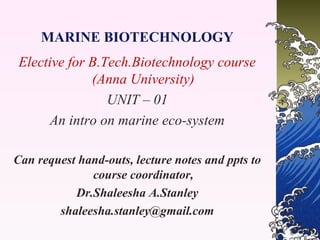
marine ecosystem
- 1. MARINE BIOTECHNOLOGY Elective for B.Tech.Biotechnology course (Anna University) UNIT – 01 An intro on marine eco-system Can request hand-outs, lecture notes and ppts to course coordinator, Dr.Shaleesha A.Stanley shaleesha.stanley@gmail.com
- 2. Introduction An aquatic ecosystem is an ecosystem located in a body of water The two main types of aquatic ecosystems are marine ecosystems and freshwater ecosystems.
- 3. Marine ECOSYSTEM Marine ecosystems cover approximately 71% of the Earth's surface and contain approximately 97% of the planet's water They are distinguished from freshwater ecosystems by the presence of dissolved SALTS, in the water Approximately 85% of the dissolved materials in seawater are sodium and chlorine Seawater has an average salinity of 35 parts per thousand (ppt) of water. Actual salinity varies among different marine ecosystems
- 4. Marine ecosystems - ecosystems Marine ecosystems can be divided into the following zones: oceanic (the relatively shallow part of the ocean that lies over the continental shelf); profundal (bottom or deep water); benthic (bottom substrates); intertidal (the area between high and low tides); estuaries; salt marshes; coral reefs; and hydrothermal vents (where chemosynthetic sulfur bacteria form the food base).
- 5. Freshwater ecosystems Freshwater ecosystems cover 0.80% of the Earth's surface and inhabit 0.009% of its total water. Freshwater ecosystems contain 41% of the world's known fish species There are three basic types of freshwater ecosystems: Lentic: slow-moving water, including pools, ponds, and lakes. Lotic: rapidly-moving water, for example streams and rivers. Wetlands: areas where the soil is saturated or inundated for at least part of the time
- 6. Lake ecosystems can be divided into zones: pelagic (open offshore waters); profundal; littoral (nearshore shallow waters); and riparian (the area of land bordering a body of water) Two important subclasses of lakes are ponds, which typically are small lakes that intergrade with wetlands, and water reservoirs. Many lakes, or bays within them, gradually become enriched by nutrients and fill in with organic sediments, a process called eutrophication. Eutrophication is accelerated by human activity within the water catchment area of the lake
- 7. anadromous fish live in the ocean mostly, and breed in fresh water catadromous fish live in fresh water, and breed in the ocean amphidromous fish move between fresh and salt water during their life cycle, but not to breed Ponds Specific type of freshwater ecosystems that are largely based on the autotroph algae which provide the base trophic level for all life in the area An autotroph, also called a producer, is an organism that produces complex organic compounds from simple inorganic molecules using energy from light (by photosynthesis) or inorganic chemical reactions ( chemosynthesis). They are the producers in a food chain, such as plants on land or algae in water.
- 8. Abiotic characteristics An ecosystem is composed of biotic communities and abiotic environmental factors, which form a self-regulating and self-sustaining unit. Abiotic environmental factors of aquatic ecosystems include temperature, salinity, and flow
- 9. Biotic components Biotic components are the living things that shape an ecosystem. A biotic factor is any living component that affects another organism, including animals that consume the organism in question, and the living food that the organism consumes. Biotic factors include human influence.
- 10. Biotic components are contrasted to abiotic components, which are non-living components of an organism's environment, such as temperature, light, moisture, air currents, etc.
- 11. Biotic components usually include: Producers, i.e. autotrophs: e.g. plants; they convert the energy (from the sun, or other sources such as hydrothermal vents) into food. Consumers, i.e. heterotrophs: e.g. animals; they depend upon producers for food. Decomposers, i.e. detritivores: e.g. fungi and bacteria; they break down chemicals from producers and consumers into simpler form which can be reused.
- 12. autotroph An autotroph, also called a producer, is an organism that produces complex organic compounds (such as carbohydrates, fats, and proteins) from simple inorganic molecules using energy from light (by photosynthesis) or inorganic chemical reactions ( chemosynthesis). They are the producers in a food chain, such as plants on land or algae in water. They are able to make their own food and can fix carbon
- 13. autotroph Autotroph can be phototrophs or lithotrophs (chemoautotrophs). Phototrophs use light as an energy source, while lithotrophs oxidize inorganic compounds, such as hydrogen sulfide, elemental sulfur, ammonium and ferrous iron. Phototrophs and lithotrophs use a portion of the ATP produced during photosynthesis or the oxidation of inorganic compounds to reduce NADP+ to NADPH in order to form organic compounds
- 14. Phototrophs Phototrophs are the organisms (usually plants) that carry out photosynthesis to acquire energy. They use the energy from sunlight to convert carbon dioxide and water into organic materials to be utilized in cellular functions such as biosynthesis and respiration.
- 16. Autotrophs
- 17. heterotroph A heterotroph is an organism that cannot fix carbon and uses organic carbon for growth
- 18. Detritivores Detritivores, also known as detritus feeders or saprophages, are heterotrophs that obtain nutrients by consuming detritus (decomposing organic matter).[1] By doing so, they contribute to decomposition and the nutrient cycles. Fungi are the primary decomposers in most environments, illustrated here Mycena interrupta. Only fungi produce the enzymes necessary to decompose lignin, a chemically complex substance found in wood. Detritivores are an important aspect of many ecosystems. They can live on any soil with an organic component, and even live in marine ecosystems where they are termed interchangeably with bottom feeders.
- 19. Abiotic component Abiotic environmental factors of aquatic ecosystems include temperature, salinity, and flow
